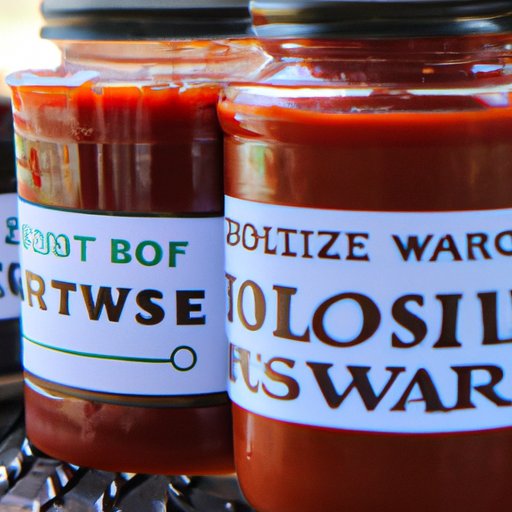Introduction
Barbecue sauce is a staple of backyard cookouts, restaurant menus, and tailgating parties across the United States. However, many people find the idea of making their own sauce intimidating, believing that it requires expert knowledge or special equipment. In this article, we’ll provide a step-by-step guide to making your own BBQ sauce and explore the science and history behind this iconic American condiment.
A Step-by-Step Guide
Making delicious BBQ sauce at home is easier than you might think. Here are the ingredients and materials you will need:
- 1 cup ketchup
- 1/2 cup brown sugar
- 1/4 cup apple cider vinegar
- 2 tablespoons Worcestershire sauce
- 1 tablespoon chili powder
- 1 tablespoon smoked paprika
- 1 teaspoon garlic powder
- 1/2 teaspoon salt
- 1/4 teaspoon black pepper
- Saucepan
- Whisk
Once you have gathered your ingredients, follow these steps:
- Combine all of the ingredients in a saucepan.
- Whisk the ingredients together until they are well combined.
- Place the saucepan over medium heat and bring the sauce to a simmer.
- Reduce the heat to low and let the sauce simmer for 15-20 minutes, stirring occasionally, to allow the flavors to meld and the sauce to thicken.
- Remove the saucepan from the heat and let the sauce cool before transferring it to an airtight container.
That’s all there is to it!
If you want to adjust the recipe to your tastes, don’t be afraid to experiment. You can add more or less of each ingredient to achieve the desired level of sweetness, spiciness, or tanginess. Depending on the type of barbecue you are making, certain ingredients may taste better than others. For example, if you’re planning to baste a rack of baby back ribs with sauce, you might want a sweeter sauce, while a tangier sauce may be better for chicken or seafood.
The Science of BBQ Sauce
There are many different styles of barbecue sauce, each with its own unique combination of flavors. Some are sweet, while others are tangy or spicy. Understanding the role of each ingredient in the sauce can help you create the perfect balance of flavors.
The three main flavor profiles in barbecue sauce are sweet, savory, and tangy. Sweetness comes from the sugar, while the savory flavor is created by Worcestershire sauce. Tanginess comes from the vinegar and mustard often used in Southern-style sauces.
Another important factor to consider is the balance of sweetness and acidity. Too much sugar can make the sauce cloyingly sweet, while too much vinegar can make it overly acidic and sharp. Finding the right balance can be tricky, but it’s key to a successful sauce.
BBQ Sauce Variations
Once you’ve mastered the basic sauce recipe, you can experiment with different variations to create your own signature barbecue sauce. Here are a few ideas to get you started:
- Spicy BBQ Sauce: Add 1/2 tablespoon cayenne pepper or 1 teaspoon hot sauce to the basic recipe.
- Tangy BBQ Sauce: Add 1/4 cup yellow mustard and 2 tablespoons honey to the basic recipe.
- Smoky BBQ Sauce: Add 1/4 cup liquid smoke or 1 teaspoon smoked salt to the basic recipe.
When pairing barbecue sauce with food, it’s important to consider the balance of flavors. Strong flavors like beef and pork can stand up to more assertive sauces, while milder meats like chicken and fish may be better suited to sweeter or tangier sauces. Vegetables like grilled corn and baked beans can also benefit from a dollop of BBQ sauce.
BBQ Sauce History
Barbecue sauce has a long and storied history, dating back thousands of years to ancient China. In the United States, barbecue sauce has been a beloved condiment for generations, with regional variations and traditions dating back to colonial times.
Today, barbeque sauce is ubiquitous at cookouts and in restaurants across the country. From the sweet and smoky flavors of Kansas City-style sauce to the tangy vinegar-based sauces of the Carolinas, there’s a BBQ sauce for every taste.
Pairing BBQ Sauce with Food
When it comes to pairing BBQ sauce with food, there are endless possibilities. Here are a few ideas to get you started:
- Sweet BBQ Sauce: Perfect for ribs, pulled pork, and chicken wings
- Tangy BBQ Sauce: Great with seafood, grilled vegetables, and baked beans
- Spicy BBQ Sauce: Ideal for beef brisket, burgers, and grilled sausage
When pairing food with BBQ sauce, it’s important to consider the balance of flavors. If your sauce is on the sweet side, for example, you might want to pair it with a more savory or salty meat to balance out the sweetness. Similarly, if your sauce is tangy or acidic, pairing it with a sweeter meat can help to balance out the flavors.
Conclusion
Making your own BBQ sauce is a fun and easy way to elevate your grilling game. Whether you prefer your sauce sweet, tangy, or spicy, experimenting with different flavor combinations can lead to some delicious results. By understanding the basic science behind BBQ sauce and exploring the rich history and regional variations of this iconic American condiment, you can become a true BBQ sauce master.
